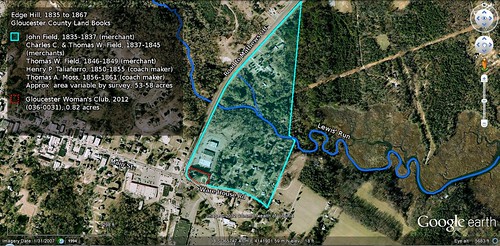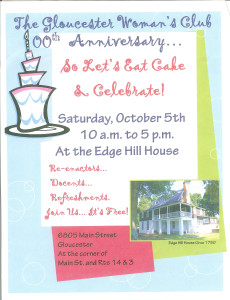The Gloucester Woman’s Club is holding their 100th Anniversary Open House on October 5th at their home, the Edge Hill House. In preparation for this event, we have been helping the Woman’s Club create new interpretive guides for visitors and historically-inspired scripts for costumed interpreters. The tour explains some of the unique stories of this historic house, allowing guests to travel back in time with guides providing opportunities to interact with former owners and residents of the house, such as 19th-century store owner John Field and 1913 Woman’s Club co-founder Marie H. Lewis.
Understanding the broad history of one building through a succession of different owners and occupants can be quite a challenge. The building operated as a home, place of business, and social club over its history from the time it was built (between 1750 and 1770) through today. Each script, based entirely on real people who lived or worked in the house, required detailed biographical research to understand personal relationships, accomplishments, and the roles played in Gloucester’s social and economic life. U.S. Census records and Gloucester County Court records are significant sources of information, but we also relied on newspapers, genealogies, and archival collections (notably at the College of William and Mary’s Swem Library) to create accurate, personal portraits. Such detailed biographical sketches reveal differences in the culture, conditions, and concerns of each period, and illustrate how each individual was connected to others in the Gloucester community.
Our involvement with the new visitor guides builds on a long-term collaboration with the Gloucester Woman’s Club and the Long Bridge Ordinary Foundation to help both organizations study, preserve, and interpret the history, architecture, and archaeology of the Edge Hill House. Archaeological excavations in 2010 revealed evidence of constant use from the late 18th through 20th centuries, and that different areas of the yard saw increasingly heavy use based on the shift from private residence to store, carriage shop, and eventually civic building.
 Volunteers Eric and Tom excavate a shovel test pit in the west yard of the Edge Hill House property in 2010.
Volunteers Eric and Tom excavate a shovel test pit in the west yard of the Edge Hill House property in 2010.
In the spring of 2012, we created a series of maps that show the changing property boundaries from ca. 1651 to the present- a project that helped us understand the broader changing landscape of downtown Gloucester Courthouse. In June of 2013, we successfully updated the property’s National Register of Historic Places Nomination, originally submitted in 1974. The expanded nomination contains important new information about the house, its owners, and its local significance from before 1770 to the present. The Woman’s Club building is now recognized as the oldest standing private dwelling in Gloucester Courthouse, with unique, intact architectural features. It is also recognized as significant for its role in the mid- to late 18th-century development of the town and the growth of commerce and industry in the 19th century, when the house was a store and coach-making shop. If you are interested in learning more about the occupation and use of the Edge Hill House over the years, and seeing additional property boundary maps, swing by the Woman’s Club event to purchase a copy of “The History of Edge Hill House: Home of the Gloucester Woman’s Club,” assembled by Bill Lawrence and on sale for $20.

Edge Hill property between 1835-1867, owned by a series of merchants and coach makers (Map by Stephen Fonzo). One of a series of maps produced illustrating the history of the property.
Perhaps most import, the updated nomination highlights the history and significant contributions of the Gloucester Woman’s Club, a pioneering social and civic organization that opened its doors to Gloucester citizens as a library, community meeting place, and non-profit historic site. the Club continues to be a steward of historic preservation with the assistance of the Long Bridge Ordinary Foundation, which formed in 1980. The updated nomination incorporates our own research with previous studies by historian Martha W. McCartney and Woman’s Club historian Elizabeth Dutton Lewis, as well as detailed notes and drawings from several architectural historians from the Colonial Williamsburg Foundation. Our work for the Gloucester Woman’s Club, including excavations, maps, National Register nomination, and interpretive visitor guides, is a successful example of our community outreach and collaborative efforts. The Woman’s Club preservation project has combined archaeology, geography, architecture, history, and biography in a way that adds substantive details to our knowledge of local history. We are proud to help the Gloucester Woman’s Club share their building and its history, and we encourage you to stop by on October 5th for the Open House.


